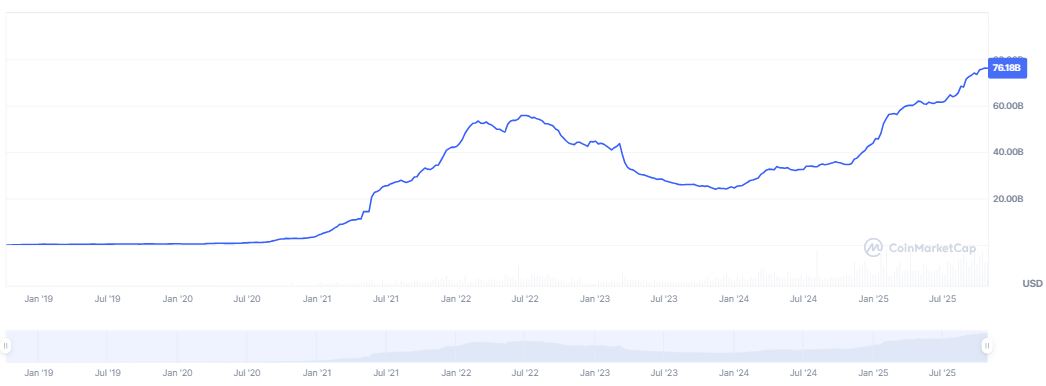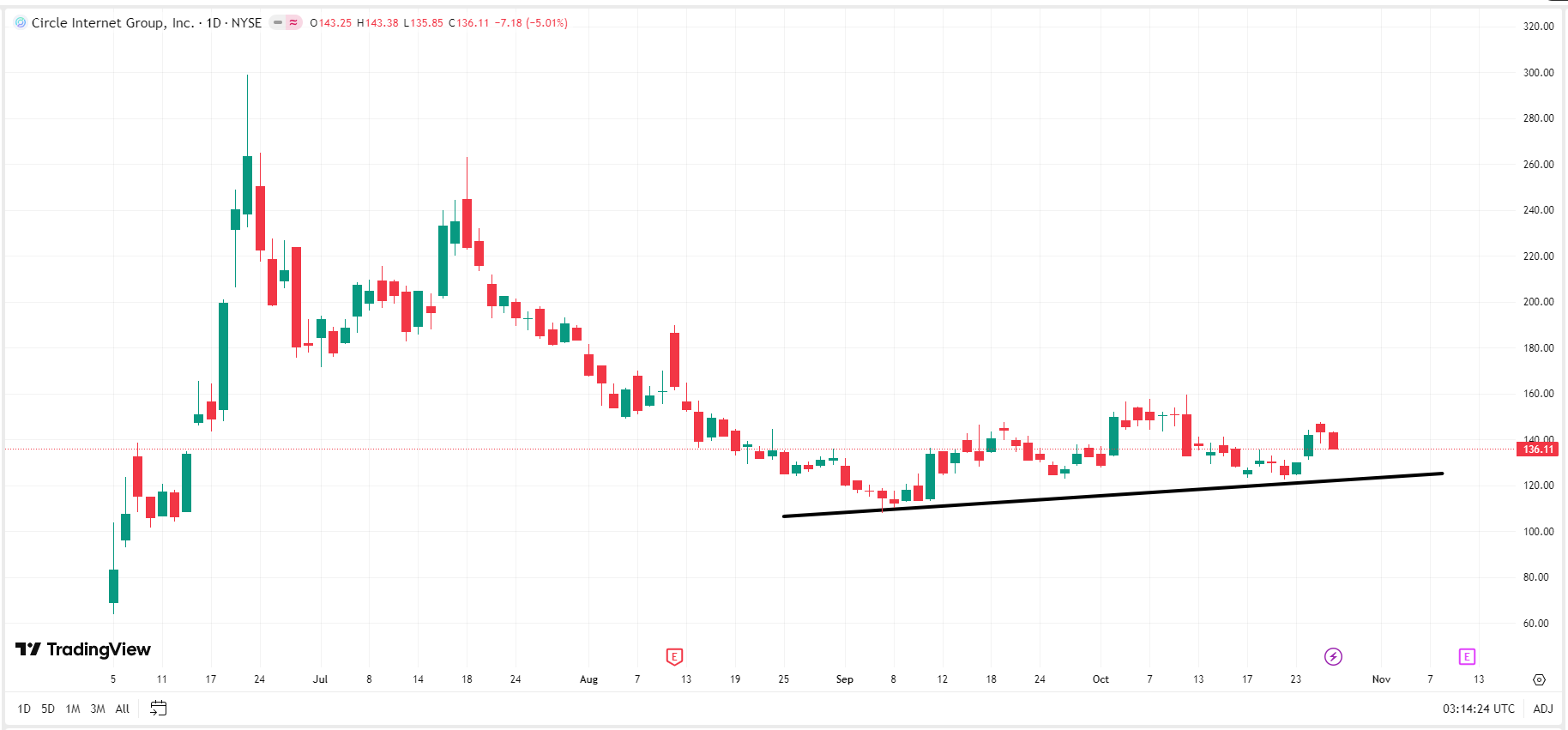What is Circle? Is CRCL Worth Investing In?
Circle (CRCL) Latest Developments
TradingKey – In June 2025, Circle debuted on the NYSE at $31 per share, becoming the first publicly listed stablecoin issuer. The IPO delivered over 8x returns at its peak, cementing Circle’s role as a bridge between crypto and traditional finance.
On October 22, Circle’s Head of Strategy Patrick Hansen revealed that in the first year of MiCA regulation, EURC — Circle’s euro-backed stablecoin — saw a 2,727% surge in transaction volume, with its market cap surpassing $280 million, making it the largest euro-denominated stablecoin.
Just days later, on October 28, USDC circulation hit 76 billion tokens, breaking Q2 records. According to Circle’s first post-IPO earnings report, USDC supply stood at 61.3 billion at the end of Q2 2025.
 USDC Supply Chart – Source: CoinMarketCap.
USDC Supply Chart – Source: CoinMarketCap.
What Is Circle (CRCL)?
Circle Internet Financial, ticker CRCL, is a U.S.-based fintech firm founded in 2013 by Jeremy Allaire and Sean Neville. Initially focused on P2P payments and remittances via Circle Pay, the company briefly operated a crypto exchange before pivoting to digital asset infrastructure. Today, Circle is best known for issuing USDC, the second-largest stablecoin globally.
In 2018, Circle co-founded the Centre Consortium with Coinbase to launch USDC. In June 2025, Circle went public, raising over $1 billion and listing on the New York Stock Exchange under the symbol CRCL.
Circle’s Product Suite
Product / Service | Description | Target Clients | Notes |
USDC & EURC | Dollar and euro stablecoins | Exchanges, DeFi, enterprises | Multi-chain support |
Institutional APIs | Minting, redemption, payments | Corporates, wallets, fintechs | Automated treasury ops |
Arc Platform | Treasury and asset tools | Financial institutions | Includes compliance reporting |
Cross-border Payments | Real-time USDC settlement | Remittance firms, global businesses | Reduces FX and wire costs |
Reserve Management | Fiat and short-term assets | Circle and partners | Transparent audits |
Compliance Tools | KYC/AML, sanctions screening | Exchanges, institutions | Regulatory alignment |
Market Liquidity | USDC liquidity and market making | CEXs, OTC desks | Supports quant and OTC desks |
Tokenization Services | Asset issuance and compliance | Enterprises, banks | Includes legal and tech stack |
Developer SDKs | USDC integration tools | Wallets, DApps | Speeds up third-party adoption |
Investor Relations | Public disclosures and reports | Shareholders, analysts | Post-IPO transparency tools |
How Circle Makes Money
Circle’s revenue model is built around two pillars:
- Reserve Yield: Circle invests fiat reserves backing USDC and EURC into low-risk, high-liquidity instruments like T-bills, bank deposits, and commercial paper, earning interest income.
- Platform & Service Fees: Circle charges for API usage, minting/redemption, enterprise integrations, and liquidity provisioning.
Revenue Stream | Description |
Reserve Yield | Interest from USDC reserves |
Transaction Fees | API, minting, redemption, settlement |
Enterprise Services | Subscriptions, integrations, advisory |
Liquidity Partnerships | Market making, OTC spreads |
Custody & Asset Management | Tokenization, advisory, custody fees |
Software Licensing | SDKs, developer tools, white-label solutions |
Annual Reserve Income:
- 2022: $735.9M
- 2023: $1.4B
- 2024: $1.7B These figures represented 95.3%, 98.6%, and 99.1% of recurring revenue, respectively.
CRCL Stock Performance & Forecast
After its IPO, CRCL opened at $69, surged to $103, and peaked at $298.99 — a 230% gain. However, by September 5, it had dropped to $108, a 63% drawdown. As of October 28, CRCL trades at $136.11, showing signs of recovery.
 CRCL Price Chart – Source: TradingView.
CRCL Price Chart – Source: TradingView.
Analyst | Rating | Target Price | Commentary |
Bernstein | Buy | $230 | Strong fundamentals, stablecoin moat |
Citigroup | Buy / High Risk | $243 | High upside, regulatory tailwinds |
Mizuho | Underperform | $85 | Regulatory competition risk |
JPMorgan | Reduce | $80 | Rate sensitivity, market saturation |
Investment Thesis: Should You Buy CRCL?
Dimension | Bull Case | Bear Case |
Business Model | Clear, cash-generating via USDC reserves | Vulnerable to rate cuts |
Market Position | Regulatory leader, BlackRock partner | Faces USDT, PYUSD competition |
Regulatory Environment | MiCA and U.S. stablecoin bill support | Global uncertainty, GENIUS Act pressure |
Growth Potential | Infrastructure for DeFi, Web3, payments | Dependent on crypto market cycles |
Circle’s IPO was a watershed moment for crypto-finance convergence. Its deep ties with BlackRock, Coinbase, and ARK Invest signal institutional confidence. However, macro headwinds — especially rate cuts and regulatory fragmentation — could compress margins and slow adoption.
How to Buy CRCL Stock
Option 1: Traditional Brokers
- Platforms: Charles Schwab, Fidelity, Robinhood, Futu, Longbridge
- Benefits: Full shareholder rights (voting, dividends)
- Order Types: Market or limit orders
Option 2: Crypto Exchanges
- Platforms: Bybit, Gate, Bitget
- Benefits: Price speculation only (no shareholder rights)
- Order Types: Market or limit orders
Conclusion
Circle (CRCL) has transformed from a crypto startup into a global stablecoin infrastructure leader. Its IPO not only validated the stablecoin business model but also opened the door for other crypto-native firms to enter public markets. While CRCL offers exposure to one of the most regulated and scalable segments of crypto, investors must weigh its sensitivity to interest rates, competitive pressures, and regulatory shifts.
FAQ
Q: Should I hold CRCL long-term or trade short-term?A: Depends on your strategy. Long-term investors should focus on fundamentals and regulatory tailwinds. Short-term traders may capitalize on volatility and news-driven moves.
Q: What are the risks of investing in CRCL?A: Market Risk: Crypto volatility impacts stock price; Regulatory Risk: Global policy shifts may constrain operations; Competitive Risk: USDT, PYUSD, and new entrants challenge market share.



